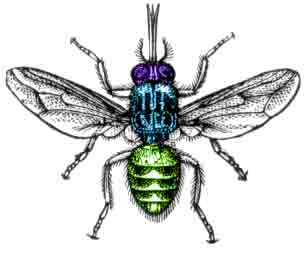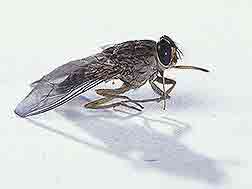|


Tsetse are biological vectors of trypanosomes meaning that tsetse, in the process of feeding, acquire and then transmit small, single-celled organisms called trypanosomes from infected vertebrate hosts to uninfected animals. Some tsetse transmitted trypanosome species cause trypanosomiasis, an infectious disease. In humans, tsetse transmitted trypanosomiasis is called sleeping sickness. In animals, tsetse vectored trypanosomiases include nagana, souma, and surra according to the animal infected and the trypanosome species involved, although the usage is not strict and nagana is occasionally used for any form of animal trypanosomiasis.
Trypanosomes are animal parasites, specifically protozoa of the genus Trypanosoma. These organisms are approximately the size of red blood cells. Different species of trypanosomes infect different hosts as can be seen in the table attached to this section. Trypanosomes range widely in their effects on the vertebrate hosts. Some species, such as Trypanosoma theileri, do not seem to cause any health problems except perhaps in animals which are already quite sick. Some strains are much more virulent. Tsetse seem to be unaffected by the infection of trypanosomes but it is entirely possible that the parasites alter tsetse behavior or have other effects which improve the chances of transmission and survival. These trypanosomes have become highly evolved and developed a life cycle which requires periods in both the vertebrate and tsetse hosts.


The tsetse vectored trypanosomiases affect various vertebrate species including humans, antelopes, bovine cattle, camels, horses, sheep, goats, and pigs. These diseases are caused by several different trypanosome species which may also survive in wild animals such as crocodiles and monitor lizards. The diseases have different distributions across the african continent and are therefore transmitted by different species of tsetse. The following table summarizes this information:
Human African trypanosomiasis, also called sleeping sickness, is caused by trypanosomes of the Trypanosoma brucei species. This disease is invariably fatal unless treated but can almost always be cured with current medicines, if the disease is caught early enough. Sleeping sickness begins with a tsetse bite leading to an inoculation in the sub-cutaneous tissue. The infection moves into the lymphatic system leading to a characteristic swelling of the lymph glands which is called Winterbottoms's sign. The infection progresses into the blood stream and eventually crosses into the central nervous system and invades the brain leading to extreme lethargy and eventually to death.
Tsetse control has been undertaken in order to reduce the incidence of the diseases which the flies transmit. Two alternative strategies have been used in the attempts to reduce the African trypanosomiases. One tactic is primarily medical or veterinary and targets the disease directly using monitoring, prophylaxis, treatment, and surveillance to reduce the number of organisms which carry the disease. The second strategy is generally entomological and intends to disrupt the cycle of transmission by reducing the number of flies..
The reduction of fly numbers has generally been attempted with two different aims, either eradication which intends to completely eliminate tsetse from the area or control which aims simply to reduce the numbers. Eradication is an idea which has often been imagined, has repeatedly been attempted, and is still proposed but many reasons suggest that control is a safer, cheaper, more realistic, and sustainable approach. Eradication refers to the successful killing of every tsetse either in a region or, under more grandiose proposals, from the entire African continent. Local eradication efforts have repeatedly been undertaken and have achieved temporary success only to fail in the long term because tsetse were able to re-invade.
The word 'tsetse' comes from Tswana, a language of southern Africa, and, in that language, the word means fly[6]. Because of this meaning, the phrase 'tsetse fly' is redundant. This is an example of "incomplete incorporation". Recently 'tsetse' without the 'fly' has become more common in English, particularly in the scientific and development communities. Because most people outside of Africa learn the word later in life through formal means, e.g. books and documentaries, the use of tsetse alone is likely to become dominant.
The pronunuciation of the word differs in different regions. Many African languages have an ejective ts sound and so a common pronunciation of the word involves two identical syllables both having this ts sound and a shorter sound of the vowel, as ts-eh-ts-eh. The British pronunciation of the word uses two different sounds for the two different syllables, generally tee-tsee. In Zimbabwe, it is generally pronounced tseh-tsee.
All text is available under the terms
of the GNU Free Documentation License
|

